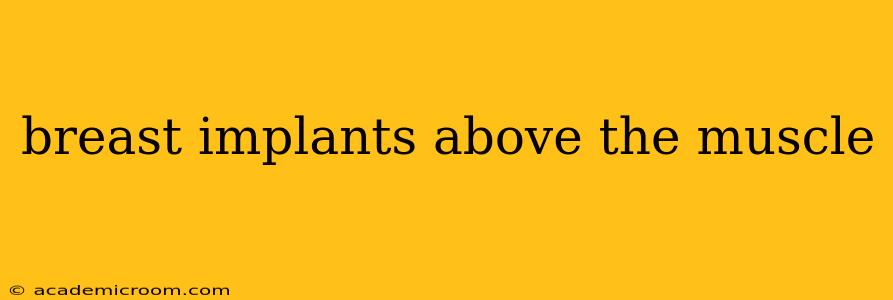Choosing the right breast augmentation technique is a deeply personal decision. One crucial aspect is the placement of the implant: above or below the pectoral muscle. This guide focuses on placing breast implants above the muscle (also known as subglandular placement), exploring its advantages, disadvantages, and answering frequently asked questions.
What is Subglandular Breast Implant Placement?
Subglandular placement involves positioning the breast implant directly on top of the pectoral muscle, underneath the breast tissue. This is in contrast to submuscular placement, where the implant sits beneath the pectoral muscle. This technique is often chosen for its potential benefits, although it's crucial to understand both the pros and cons before making a decision.
Advantages of Placing Breast Implants Above the Muscle
- Faster Recovery: Many patients find that recovery is quicker with subglandular placement compared to submuscular placement. This is because the muscle isn't manipulated during the procedure, potentially leading to less post-operative pain and discomfort.
- Less Muscle Soreness: Since the muscle isn't involved in the implant placement, post-operative muscle soreness is usually minimal. This can translate to a faster return to normal activities.
- Higher Breast Position: In some cases, subglandular placement can result in a higher breast position, giving a more lifted appearance.
- Potentially Lower Implant Visibility: For some patients, the implant might be less visible through the skin with subglandular placement. This is especially true with smaller implants.
- Less Capsular Contracture: While capsular contracture can occur with any placement, some surgeons believe that the subglandular technique may slightly reduce the risk. This is because there’s less potential for muscle tension or inflammation to impact the implant's capsule.
Disadvantages of Placing Breast Implants Above the Muscle
- Increased Implant Visibility: One potential drawback is that implants can sometimes be more visible or palpable through the skin, especially with larger implants or thinner breast tissue.
- Higher Risk of Rippling: The implant may be more prone to rippling or wrinkling of the skin, again more likely with larger implants and thinner breast tissue.
- Higher Risk of Implant Rotation: The implant might be more likely to shift or rotate, especially in the early stages of recovery.
- Increased Sensitivity: Some patients report increased breast sensitivity, while others report no change or decreased sensitivity.
- Not Suitable for All Patients: This technique may not be appropriate for all patients, depending on breast tissue volume, anatomy, and overall health.
What are the Risks of Subglandular Breast Implants?
While subglandular placement offers advantages, it’s important to be aware of potential risks, which are similar to those associated with submuscular placement. These include:
- Infection: As with any surgical procedure, there's a risk of infection at the surgical site.
- Bleeding and Hematoma: Excessive bleeding or the formation of a blood clot (hematoma) are possible.
- Capsular Contracture: The formation of scar tissue around the implant (capsular contracture) can lead to pain, hardening, and changes in breast shape.
- Implant Rupture or Leakage: Although rare, there's a chance of the implant rupturing or leaking.
- Nerve Damage: Damage to nerves during the procedure is a possibility, though rare.
Is Subglandular Implant Placement Right for Me?
The decision of whether subglandular or submuscular placement is best depends on several individual factors. These include:
- Breast tissue volume: Thinner breast tissue may be less suitable for subglandular placement.
- Body type: Certain body types may be better suited for one technique over the other.
- Desired outcome: Your personal goals and preferences will play a significant role.
- Surgeon's recommendation: Your surgeon will evaluate your individual anatomy and medical history to determine the most appropriate technique for you. A thorough consultation is essential.
How Long Does it Take to Recover from Subglandular Breast Implant Surgery?
Recovery time varies from person to person, but generally, patients can expect to return to most normal activities within a few weeks. However, strenuous activities should be avoided for several weeks. Your surgeon will provide specific post-operative instructions.
What is the Difference Between Subglandular and Submuscular Implant Placement?
The key difference lies in the placement of the implant relative to the pectoral muscle. Subglandular places the implant on top of the muscle, while submuscular places it underneath. This difference affects recovery time, potential complications, and aesthetic results.
Can I Breastfeed After Subglandular Breast Implant Surgery?
While breast implants themselves generally don’t affect breastfeeding, the surgery may temporarily impact milk production. It's crucial to discuss breastfeeding plans with your surgeon before the procedure.
What are the Long-Term Effects of Subglandular Breast Implants?
Long-term effects can vary. Regular check-ups with your surgeon are essential for monitoring implant integrity and detecting any potential problems. Implants may need replacement after a certain number of years.
Ultimately, the decision regarding breast implant placement requires careful consideration and consultation with a qualified and experienced plastic surgeon. This information is for educational purposes only and does not constitute medical advice. Always seek professional medical advice for any health concerns.
